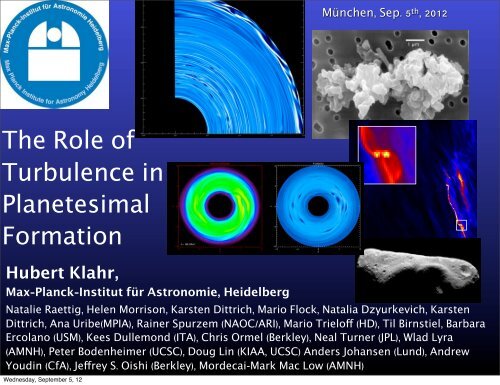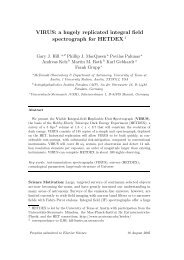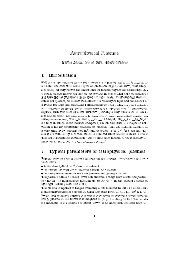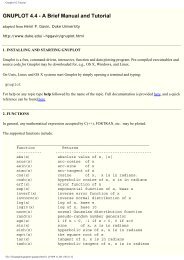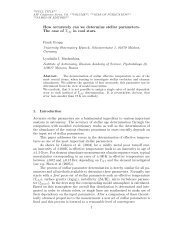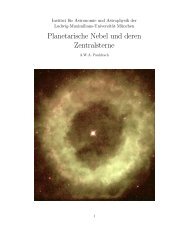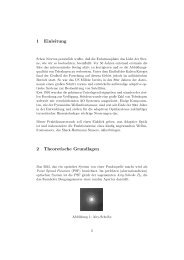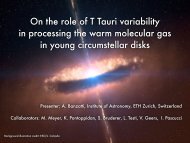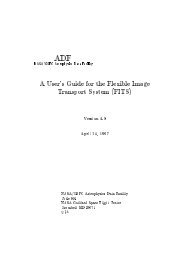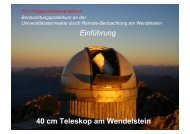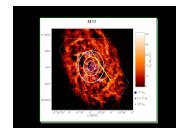pdf 3.6 MB
pdf 3.6 MB
pdf 3.6 MB
Create successful ePaper yourself
Turn your PDF publications into a flip-book with our unique Google optimized e-Paper software.
The Role of<br />
Turbulence in<br />
Planetesimal<br />
Formation<br />
Hubert Klahr,<br />
200<br />
100<br />
500<br />
400<br />
300<br />
200<br />
100<br />
0<br />
0 100 200 300 400 500<br />
0<br />
t=36.1<br />
München, Sep. 5 th, 2012<br />
0<br />
0 100 200 300 400<br />
Max-Planck-Institut für Astronomie, 0 100 200Heidelberg 300 400 500<br />
t=36.3<br />
t=36.5<br />
Natalie Raettig, Helen Morrison, Karsten Dittrich, Mario Flock, Natalia Dzyurkevich, Karsten<br />
500<br />
500<br />
Dittrich, Ana Uribe(MPIA), Rainer Spurzem (NAOC/ARI), Mario Trieloff (HD), Til Birnstiel, Barbara<br />
Ercolano (USM), Kees Dullemond (ITA), Chris Ormel (Berkley), Neal Turner (JPL), Wlad Lyra<br />
(AMNH), 12/13/2009 400<br />
Peter Bodenheimer (UCSC), Hubert Doug Klahr Lin - Planet (KIAA, Formation UCSC) - MPIA 400<br />
Anders Johansen (Lund), 1 Andrew<br />
Heidelberg<br />
Youdin (CfA), Jeffrey S. Oishi (Berkley), Mordecai-Mark Mac Low (AMNH)<br />
Wednesday, September 5, 12<br />
300<br />
200<br />
100<br />
500<br />
400<br />
300<br />
200<br />
100<br />
300<br />
t=36.2<br />
0<br />
0 100 200 300 400
Outline:<br />
• Capturing Dust in Pressure maxima e.g.<br />
Zonal flows and vortices<br />
• MHD turbulence and Gravoturbulent<br />
Planetesimal formation -> Karsten Dittrich<br />
• Turbulence and vortices in Baroclinic<br />
disks: Disk Weather<br />
• Modified Symmetric Instability<br />
• Dust capturing in 3D vortices<br />
• Summary, Conclusions<br />
12/13/2009 Hubert Klahr - Planet Formation - MPIA<br />
Heidelberg<br />
Wednesday, September 5, 12<br />
The role of<br />
Turbulence in<br />
Planet Formation
Turbulence in a non rotating frame:<br />
Cuzzi et al.<br />
12/13/2009 Hubert Klahr - Planet Formation - MPIA<br />
Heidelberg<br />
Wednesday, September 5, 12<br />
L<br />
H<br />
Laboratory Conditions<br />
Dust collects between<br />
vortices (high pressure)
Particle response in rotating (DISK) frame:<br />
Geostophic flow: balance of pressure and Coriolis forces<br />
VORTICES:<br />
Barge & Sommeria 1995 ZONAL FLOWS:<br />
12/13/2009 Hubert Klahr - Planet Formation - MPIA<br />
Heidelberg<br />
Wednesday, September 5, 12<br />
H<br />
L<br />
H<br />
Radial Pressure maxima<br />
Klahr & Lin 2000
V<br />
e<br />
r<br />
t<br />
i<br />
c<br />
a<br />
l<br />
From dust/gas eq. 1 => Streaming Instability -<br />
> dust densities larger than local Roche<br />
density, e.g. Planetesimals can form.<br />
h o r i z o n t a l<br />
12/13/2009 Hubert Klahr - Planet Formation - MPIA<br />
Heidelberg<br />
Wednesday, September 5, 12<br />
Johansen, Henning & Klahr 2006
V<br />
e<br />
r<br />
t<br />
i<br />
c<br />
a<br />
l<br />
From dust/gas eq. 1 => Streaming Instability -<br />
> dust densities larger than local Roche<br />
density, e.g. Planetesimals can form.<br />
h o r i z o n t a l<br />
12/13/2009 Hubert Klahr - Planet Formation - MPIA<br />
Heidelberg<br />
Wednesday, September 5, 12<br />
Johansen, Henning & Klahr 2006
Disk:<br />
12/13/2009 Hubert Klahr - Planet Formation - MPIA<br />
Heidelberg<br />
Wednesday, September 5, 12<br />
…because it is a reliable source for turbulence.<br />
Box:<br />
6
MHD plus self-gravity for the dust, including particle feed back<br />
on the gas:<br />
gas<br />
dust<br />
Poisson equation solved via FFT in parallel mode: up to 256 3 cells<br />
12/13/2009 Hubert Klahr - Planet Formation - MPIA<br />
Heidelberg<br />
Wednesday, September 5, 12
Formation Of<br />
Planetesimals<br />
From pressure<br />
trapped /<br />
gravitational<br />
Bound heaps of<br />
gravel - here<br />
magnetic<br />
turbulence:<br />
Johansen, Klahr &<br />
Henning 2011.<br />
Next: Raettig &<br />
Lyra<br />
512 ^2 simulation<br />
64 Mio particles<br />
Entire project<br />
used 15 Mio. CPU<br />
hours.<br />
12/13/2009 Hubert Klahr - Planet Formation - MPIA<br />
Heidelberg<br />
Wednesday, September 5, 12<br />
Concentration in Zonal Flows:<br />
8
Wednesday, September 5, 12<br />
At 5123 100 and the usual set 100 up: As before mass of<br />
planetesimals 0 depends on 0 the available mass.<br />
500<br />
400<br />
300<br />
200<br />
100<br />
500<br />
400<br />
300<br />
200<br />
100<br />
0 100 200 300 400 500<br />
t=36.1<br />
0<br />
0 100 200 300 400 500<br />
t=36.3<br />
0<br />
0 100 200 300 400 500<br />
0 100 200 300 400 500<br />
t=36.2<br />
0<br />
0 100 200 300 400 500<br />
new: Intermediate Formation of Binaries;<br />
Johansen, Klahr & Henning (2011)<br />
500<br />
400<br />
300<br />
200<br />
100<br />
500<br />
400<br />
300<br />
200<br />
100<br />
t=36.5<br />
0<br />
0 100 200 300 400 500<br />
Fig. 6. The particle column density as a function of time after self-gravity is turned on after t = 35.0Torb. Theinsertshowsanenlargementofthe<br />
region around the point of highest column density.
Not the process but numerical resolution limit the smallest<br />
possible planetesimals. Johansen, Klahr & Henning 2011<br />
To predict an initial mass distribution of<br />
Planetesimals one needs A: the proper size<br />
distribution of precursors and B: the likely hood<br />
12/13/2009 for concentrations Hubert as Klahr a - Planet function Formation - MPIA of particle size. 10<br />
Heidelberg<br />
Wednesday, September 5, 12
Wednesday, September 5, 12<br />
Larger Boxes = better concentration<br />
Dittrich, Klahr & Johansen submitted<br />
See Talk by Karsten Dittrich
Natalia Dziurkevich (in prep.) see her POSTER!<br />
Active (Blue) and Dead (Yellow/Orange) Zones<br />
12/13/2009 => Planetesimals Hubert are Klahr - needed Planet Formation in - MPIA the Dead Zone. 12<br />
Heidelberg<br />
Wednesday, September 5, 12
12/13/2009 Hubert Klahr - Planet Formation - MPIA<br />
Heidelberg<br />
Wednesday, September 5, 12<br />
Baroclinic Effects on Earth:<br />
Formation of Hurricanes<br />
13
12/13/2009 Hubert Klahr - Planet Formation - MPIA<br />
Heidelberg<br />
Wednesday, September 5, 12<br />
Geophysical Baroclinic Instability<br />
14
�[g/cm 2 ]<br />
Klahr & Raettig in prep.<br />
Using data from Sean Andrews<br />
alpha = 0.001; Mdot = 1E-7 Msol/yr;<br />
Plus irradiation: Tstar = 4300; Rstar = 2 Rsol<br />
10 5<br />
10 4<br />
10 3<br />
10 2<br />
0.1 1.0 10.0 100.0<br />
r[AU]<br />
12/13/2009 Hubert Klahr - Planet Formation - MPIA<br />
Heidelberg<br />
Wednesday, September 5, 12<br />
T[K]<br />
10000<br />
1000<br />
100<br />
10<br />
0.1 1.0 10.0 100.0<br />
r[AU]<br />
15
Ri<br />
0.001<br />
0.000<br />
�0.001<br />
�0.002<br />
�0.003<br />
Richardson number &<br />
Thermal diffusion time<br />
�0.004<br />
0.1 1.0 10.0 100.0<br />
r[AU]<br />
� therm<br />
12/13/2009 Hubert Klahr - Planet Formation - MPIA<br />
Heidelberg<br />
N 2 = 1<br />
100.0<br />
10.0<br />
1.0<br />
⇤<br />
Ri 2 =<br />
H<br />
R ⇥s⇥p<br />
N 2<br />
3<br />
2<br />
⇥ 2<br />
⇧therm = H 2 / D<br />
The saturated state presents a turbulent flow dominated b<br />
(Mamatsashvili & Chagelishvili 2007 ;Heinemann & Papaloizo<br />
fluctuation of 10% of the speed of sound and producing -valu<br />
10 3. Vortices are forming spontaneously out of the creation o<br />
⌅cv<br />
0.1<br />
0.1 1.0 10.0 100.0<br />
r[AU]<br />
vortices show no sign of decay, yet draw the energy out of the g<br />
providing entropy flux downward the gradient, like in standard<br />
Wednesday, September 5, 12<br />
MRI BI<br />
16<br />
2
12/13/2009 Hubert Klahr - Planet Formation - MPIA<br />
Heidelberg<br />
Wednesday, September 5, 12<br />
Strength of alpha?<br />
Raettig, Klahr and Lyra, submitted<br />
17
12/13/2009 Hubert Klahr - Planet Formation - MPIA<br />
Heidelberg<br />
Wednesday, September 5, 12<br />
Pluto Code: 1024^2; WENO3-RK3; HLLE; FARGO<br />
vortices migrate inward, but are recreated by<br />
waves from other vortices.<br />
18
Pluto Code: 1024^2; WENO3-RK3;<br />
HLLE; FARGO<br />
Spirals spawn new vortices further<br />
out, many cycles of vortices!<br />
12/13/2009 Hubert Klahr - Planet Formation - MPIA<br />
Heidelberg<br />
Wednesday, September 5, 12<br />
19
2D axissymetric Pluto Simulation: Temperature<br />
due to irradiation from star and thermal<br />
relaxation tau = 0.1 (also works for flux limited<br />
diffusion in irradiated disks)<br />
12/13/2009 Hubert Klahr - Planet Formation - MPIA<br />
Heidelberg<br />
Wednesday, September 5, 12<br />
Star-><br />
Thermal wind:<br />
20
2D axissymetric Pluto Simulation:<br />
Overstability due to thermal wind leads to<br />
convection like motion: Symmetric Instability<br />
12/13/2009 Hubert Klahr - Planet Formation - MPIA<br />
Heidelberg<br />
Wednesday, September 5, 12<br />
Modification of Solberg-Hoiland Criterion, including thermal relaxation:<br />
In collaboration with Alexander Hubbard<br />
21
2D axissymetric Pluto Simulation: Resulting<br />
vorticity perturbations<br />
12/13/2009 Hubert Klahr - Planet Formation - MPIA<br />
Heidelberg<br />
Wednesday, September 5, 12<br />
22
Full 3D Pluto Simulation: Spontanous Formation<br />
of Vortices from tiny perturabtions<br />
12/13/2009 Hubert Klahr - Planet Formation - MPIA<br />
Heidelberg<br />
Wednesday, September 5, 12<br />
23
Interface<br />
MRI - Dead Zone<br />
linear<br />
axisymmetric<br />
Instability:<br />
Solberg-Hoiland<br />
Disk Weather<br />
Papaloizou-Pringle<br />
Rossby Wave Inst.<br />
classic<br />
baroclinic<br />
instability<br />
Radial Buoyancy : dS/dr < 0 & dP/dr thermal wind dVphi/dz < 0 plus: thermal relaxation<br />
24<br />
Wednesday, September 5, 12
Interface<br />
MRI - Dead Zone<br />
linear<br />
axisymmetric<br />
Instability:<br />
Solberg-Hoiland<br />
Disk Weather<br />
Papaloizou-Pringle<br />
Rossby Wave Inst.<br />
classic<br />
baroclinic<br />
instability<br />
Radial Buoyancy : dS/dr < 0 & dP/dr thermal wind dVphi/dz < 0 plus: thermal relaxation<br />
24<br />
Wednesday, September 5, 12
Small particles in pressure maxima e.g. a vortex<br />
e.g. Vortex is in balance between Coriolis forces and<br />
pressure = same for Zonal flow.<br />
H<br />
12/13/2009 Hubert Klahr - Planet Formation - MPIA<br />
Heidelberg<br />
Wednesday, September 5, 12<br />
L
St = 0.05 particles (few millimeter)<br />
(white = x 1000) Natalie Raettig<br />
12/13/2009 Hubert Klahr - Planet Formation - MPIA<br />
Heidelberg<br />
Wednesday, September 5, 12<br />
26
St = 0.05 particles (few millimeter)<br />
(white = x 1000) Natalie Raettig<br />
12/13/2009 Hubert Klahr - Planet Formation - MPIA<br />
Heidelberg<br />
Wednesday, September 5, 12<br />
NEXT STEP:<br />
SELF GRAVITY<br />
26
Dust Concentration in 3D Vortices:<br />
Raettig and Klahr, in prep<br />
12/13/2009 Hubert Klahr - Planet Formation - MPIA<br />
Heidelberg<br />
Wednesday, September 5, 12<br />
27
Conclusions:<br />
Johansen and Klahr: High resolution simulations of planetesimal formation 7<br />
t=35.0<br />
500<br />
400<br />
t=35.7<br />
• Disk turbulence can be magnetic in nature, but in<br />
resistive regions the entropy structure of the disk<br />
300<br />
creates a thermal wind and eventually vortices.<br />
• Any turbulence with 200 gravity can form rapidly<br />
planetesimals over a broad range of sizes<br />
100<br />
• Vortices can concentrate St = 0.05 dust at initial<br />
abundance of eps = 1E-4 to the streaming<br />
0<br />
200instability 300 400and 500 planetesimal 0 100 formation.<br />
200 300 400 500<br />
t=36.1 t=36.2<br />
12/13/2009 Hubert Klahr - Planet Formation - MPIA<br />
200<br />
Heidelberg<br />
Wednesday, September 5, 12<br />
500<br />
400<br />
300<br />
28


